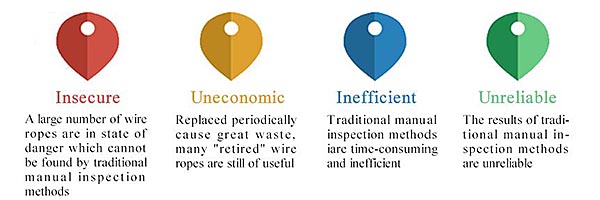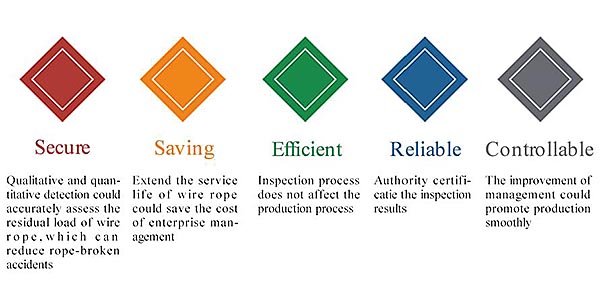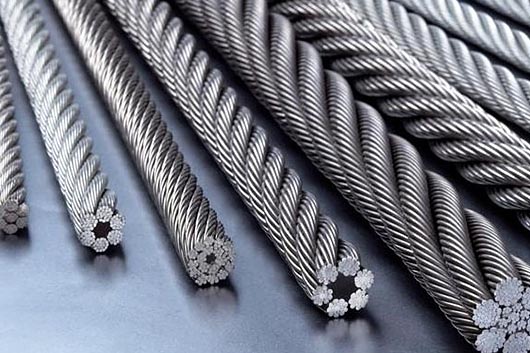1. Items of manual inspection
In general, all running ropes (except elevator ropes) in continuous service must be inspected once every working day, and a thorough inspection of all ropes in use should be made at least once a month with a full, written, dated and signed report of rope condition that should be kept on file. Trained and authorized designated personnel must make inspection. Inspection items for determination of need for cable replacement should include the following:
•Reduction of rope diameter
•Presence of broken wires and the degree of distribution or concentration
•Outside wire wear
•Evidence of heat damage from any cause
•Suspicion of lightning strikes
•Failure to have bearings on hooks turn freely and thus cause rope to twist or not work according to design
•Corroded, fatigued or broken wires at end connections
•Corroded, cracked, bent, worn or improperly applied end connections
•Severe kinking, crushing, cutting or unstranding
2. Replacement conditions for wire rope
No precise rules can be made for determining the exact time wire rope should be replaced. Safety mainly depends on the judgment of the qualified person who evaluates the strength remaining in a used rope after allowing for deterioration disclosed by inspection.
The following conditions are cited from a section of OSHA regulations as typical criteria to question rope safety:
•In running ropes, six randomly distributed broken wires in one lay or three broken wires in one strand of one lay
•Wear of one-third the original diameter of individual outside wires
•Kinking (not to be confused with dog legging), crushing, bird-caging or other damage resulting in distortion of the rope structure
•Evidence of heat damage from any cause, such as exposure to heat above recommended limits, (e.g., when used to soak heated billets, lift forgings or exposure to burning torches
•Excessive elongation or sharp reduction in diameter, which means replacement is necessnary
•In standing ropes, more than two broken wires in one lay in sections beyond end connections, or more than one broken wire at an end connection
•Contact with an energized electrical conductor
(Note: the above quoted from 《National Safety Council Data Sheet 667 Reaf. 89 Rev. June 2005》)
3. Problems of manual inspection
Manual inspection method is widely existed in the world, however, a variety of problems caused by manual inspection lead to the safety condition of wire rope is not optimistic at present, mainly reflected in following aspects:

4. TST Flaw Detection Technology Co., Ltd. (TST)
TST is a company that provides equipment and solution for advanced onsite NDT inspection and lubrication of steel wire ropes.
TST Flaw Detection System (TST FDSysTM) is created by TST scientists and engineers to automatically inspect the physical flaws on the wire ropes. Given the inspected flaw data, the system can thus make evaluations of the wire rope safety status and operating performance of the targets. For the onsite engineers and operating managers, TST-FDSysTM will provide both realtime wire rope inspection monitor alongside the producing operation and comprehensive report at end of per inspection task. Therefore, flaws on the inspecting target will be noticed instantly wherever it appears and the automatically generated report will demonstrate the overall status of the target with detailed analysis of each inspected flaw.
The value of TST technology and solution is generated from five aspects:

The product category of TST as follows:
•TST-FDSysTM- Protable
•TST-FDSysTM- REALTIME WIRE ROPE
•TST-FDSysTM- REALTIME CONVEYOR BELT
•TST-Viper Wire Rope Lubricator
TST Flaw Detection System has been widely adapted and applied in many fields: port & shipyard, mining, military, amusement & cableway, oil & gas, elevators and so on.
More Than Safer
prev: Care And Inspection of Wire Rope
next: TST has gain State Scientific Research Subsidies again








